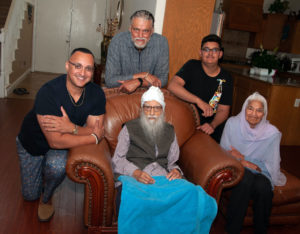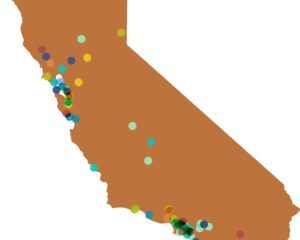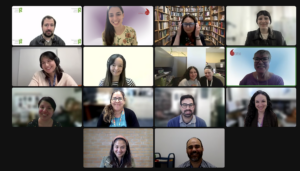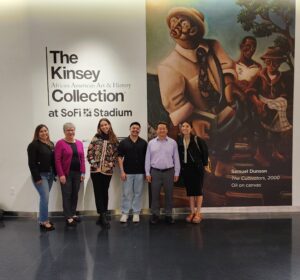“The understanding of a culture comes from hearing the language, tasting the food, seeing personal interactions, experiencing the traditions, and so much more when it is in context. The more stories we can tell, the more accurate understanding we can foster.” – Elizabeth Laval & Candice Pendergrass, Fresno County Historical Society
 In this blog post, we interview “Jakara: Sikh Youth Public History” project directors Elizabeth Laval & Candice Pendergrass from the Fresno County Historical Society. Supported by a Humanities for All Project grant, Laval and Pendergrass share more about how this project records, preserves, and makes the little-known history of the Sikh and South Asian communities in Fresno County more visible by enabling youth to become the collectors and curators of their personal and family histories. They explain that through the project, teens and other participants develop a deeper understanding of the international context of their family history through interviews, research, oral history collection, and digitizing family photographs and documents.
In this blog post, we interview “Jakara: Sikh Youth Public History” project directors Elizabeth Laval & Candice Pendergrass from the Fresno County Historical Society. Supported by a Humanities for All Project grant, Laval and Pendergrass share more about how this project records, preserves, and makes the little-known history of the Sikh and South Asian communities in Fresno County more visible by enabling youth to become the collectors and curators of their personal and family histories. They explain that through the project, teens and other participants develop a deeper understanding of the international context of their family history through interviews, research, oral history collection, and digitizing family photographs and documents.
What inspired Fresno County Historical Society (FCHS) to undertake this project?
When the Fresno County Historical Society reached its centennial in 2019, a “top-to-toe” strategic plan was set in place to ensure the organization’s mission was aligned with the way our region looks today. As per the census, our population mix looked vastly different a century ago, as you can imagine. Also, technology for preservation has emerged so rapidly that, in my opinion, there has never been a more exciting time to be working in this field. As a documentary filmmaker for Valley PBS for nearly a decade, I (Elizabeth Laval) met and worked with so many of our cultural populations. I realized how so many stories would be lost if not captured as soon as possible. Part of this relates to making sure young people have the chance to hear about their ancestry – the compelling reasons that caused them to leave their homelands for America, what conditions they encountered when they arrived, and how they preserve and blend their traditions in their adopted countries and so much more.
The FCHS embarked on an ongoing video Oral History Project to capture as many threads in the variegated tapestry that makes up the Central Valley as possible. While some efforts had been made in the past to record stories in our African American, Latino, Japanese and Italian communities, the Sikh immigrant tales had yet to be told. And, truly, time is running out to learn from the first generation who made the Central Valley their home. Oh, and we have been practicing – it is correctly pronounced SIKH – like sickh with a short “i” sound. Don’t drag out the “i!”
How has the Sikh community been involved in planning and implementing the project? Who else are you working with?
 As you can imagine, a project like this would not work without trusted Sikh American partners. Particularly after 9/11, sadly, this community, as well as so many others of Middle Eastern and Asian descent, were swathed with the brush of bigotry and misunderstanding. We were fortunate to work with several Sikh American farmers and businessmen who were enthusiastic to join us in this project. The cooperation was slow to warm up, but because we had such wonderful cultural advisors, we have now been welcomed into the Sikh family, so to speak. One of the most important pieces of solving this puzzle was appearing on local Punjabi television, which greatly solidified the project’s legitimacy and appeal. We are all learning a lot!
As you can imagine, a project like this would not work without trusted Sikh American partners. Particularly after 9/11, sadly, this community, as well as so many others of Middle Eastern and Asian descent, were swathed with the brush of bigotry and misunderstanding. We were fortunate to work with several Sikh American farmers and businessmen who were enthusiastic to join us in this project. The cooperation was slow to warm up, but because we had such wonderful cultural advisors, we have now been welcomed into the Sikh family, so to speak. One of the most important pieces of solving this puzzle was appearing on local Punjabi television, which greatly solidified the project’s legitimacy and appeal. We are all learning a lot!
Why is it important that young people are involved in this project? 
The real success of this project hinged on involving the students as interviewers and building trust. Participation has gone from a suspicious curiosity to a heartfelt honor for those participating, and the elders and others in the community are thrilled that their youngsters are being given the training and opportunity to learn from professionals in the documentary and oral history fields. Also, part of the FCHS’s mission is to help young people realize that they are “MAKING HISTORY EVERY DAY” and not just the cataloging of old diaries and newspapers but a living, ever evolving and always elusive entity. As we are helping teachers and students rethink how history is portrayed through the use of multiple sources – much more attainable now with digitization – we are now trying to make sure those sources exist in our region. One example: we created a living COVID-19 archive where everyone of all ages, from teachers, students, parents, first responders, and more, could memorialize their feelings at the time to go along with press releases, newspaper articles, and social media posts. It seems we all agree that, in 50 years, reading about a 5th grader’s concerns for his mom and dad’s jobs during the Covid-19 lockdown will add a human dimension that has often been missing in the past.
How has the oral history work been going? What have young people been learning from their research? Have there been any surprises?
Well, it seems we have all been surprised at this project’s complexity, including our humanities advisors. Covid-19 has also been a factor and has slowed the gathering process, but we are crossing our fingers to catch a break for a few months. Many students participate in their school’s AV classes and thought they would be naturals even in front of the cameras. However, their tune changed quickly when they had to prepare questions and, sometimes, interview their elderly grandparents or an admired businessperson or teacher. We are keeping the early raw footage so they can see how much progress they are making and how their confidence has grown. As we work with the students and interview THEM so they can empathize with their subjects a bit more, they find themselves at a loss for words initially, but we love watching the comfort level grow.
Also, we think they are startled to realize how little they know about how their families came to the U.S., why they came and what their lives in India were actually like. We see the most emotion when they see photos of where they could have grown up and then begin to realize the sacrifices their families made to give them a better life – and what those words actually mean.
Can you give us a preview of the exhibit and other public-facing products?
We will be conducting all the final interviews this summer while the students have the most time at several collection events. This was our original plan, but as we got to know the community better, we will also allow the students to do one-on-one interviews in homes or businesses if that is more comfortable for the interviewee. Another edit we are making is that the oral histories were going to be filmed with the students behind the cameras asking questions. Still, we are finding side-by-side may work better, especially with our elderly subjects. A true game-changer was when people learned they could answer in Punjabi if necessary, and the students would get the interview translated.
The culmination event will be in the fall, where all the oral histories and a photo exhibit will be revealed, and a grand Sikh celebration will be held for all to attend. Our local media is already covering the project’s progress, so we expect the reveal to be well-publicized, and the launch onto the website will be significant. Our local school districts are looking forward to having access as part of our Time Travelers’ curriculum. All will be available at valleyhistory.org.
What do you hope will be the long-term results of this project?
It almost sounds trite to say, but our country and, indeed, the world will simply not survive without improvements in cultural and ethnic understanding. It doesn’t work to say that people are all the same or rely on some of the other adages that are so glibly thrown around. In my younger years, I (Elizabeth Laval) had a job based in Asia that took me to over 40 countries on nearly every continent. Those were the days before the internet and email, so you had to get on a plane and travel to do business. The understanding of a culture comes from hearing the language, tasting the food, seeing personal interactions, experiencing the traditions, and so much more when it is in context. While the web has made the world smaller, to me, it has widened the cultural gap in many ways because people see a snippet of a post and think they understand much more than they possibly could. Watching oral histories and seeing the photos of the lives of these people as youth or their parents in their homeland or aunts and uncles they never met and hearing the stories with the emotion that is so often evoked is almost like traveling back in time for those precious moments in a way just reading a book cannot replicate. The more stories we can tell, the more accurate understanding we can foster. Thank you so very much for allowing us to create this project. We are truly honored and grateful.
Read more about the project in this GV Wire article, Local History Project Trains Students to Tell Sikh Community Stories.





